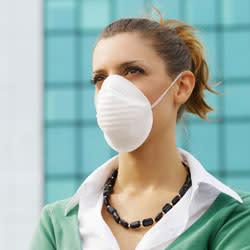Protecting yourself against air pollution

© Thinkstock
The UK Department for environment, food and rural affairs runs the UK-AIR website and forecast service to keep you informed about pollution levels. Air pollution measures currently cover five pollutants: ozone, nitrogen dioxide, sulphur dioxide, carbon monoxide and PM10 particles.
Measuring the impact of air pollution
Four pollution levels have been developed according to the concentrations of each of these substances in the atmosphere (taking into account the different thresholds for each pollutant), and the possible impact to people’s health.
Low (1, 2, 3): Effects are unlikely to be noticed even by individuals who know they are sensitive to air pollutants.
Moderate (4, 5, 6): Mild effects, unlikely to require action, may be noticed amongst sensitive individuals.
High (7, 8, 9): Significant effects may be noticed by sensitive individuals and action to avoid or reduce these effects may be needed.
Very High (10): The effects on sensitive individuals described for 'High' levels of pollution may worsen.
Source: UK-AIR, Air Pollution Bandings
Those most at risk from air pollution
The elderly, small children and those suffering from respiratory problems such as asthma, and those with allergies or any other chronic respiratory illness are the most sensitive to atmospheric pollution.
It’s advisable for these people to avoid strenuous outside physical activity during the Moderate level of alert (the stage at which the public is informed). On the other hand, there is no need to limit going outdoors. So it’s not necessary to stop children going to the swimming pool or playing outdoors.
However, when conditions have reached the High level, outdoor activities should be kept to a minimum for those most likely to be affected by the pollution. Furthermore, during these episodes of a peak in pollution, treatment for asthma sufferers or for other respiratory problems should be adapted accordingly, as these conditions can often exacerbate symptoms.
Air pollution and the morning jog
If conditions give rise to a Very High, it is recommended that those at risk avoid going outdoors during the hottest part of the day. And any strenuous sporting activity is inadvisable even for those who don’t have health problems.
Physical activity is accompanied by an increase in respiratory rhythm and larger inhalation of pollutants in the atmosphere, which will penetrate the lungs more deeply.
Serious joggers who need their daily dose, should make every effort to go running first thing in the morning, as the concentration of ozone has a tendency to increase during the course of the day. Those looking after children, especially in summer camps, should limit sporting activity and outdoor games to mornings only.
Air pollution in the home
Other advice is helpful for the entire population. It is obvious that the addition of other toxic pollutants in the air will only amplify the harmful effects of atmospheric pollution.
This is true of tobacco, of course, but also solvents and other substances contained in household products for cleaning and DIY. It is therefore a good idea to air all rooms first thing in the morning or at night rather than during the day during days with spikes of pollution. This will refresh your home in general.
Finally, you should consult your doctor if any symptoms of irritation occur (conjunctivitis, coughing, a tickling throat etc.) or if a pre-existing respiratory condition shows signs of increased aggravation.
Source: UK-AIR
More information:
Safety and health at work
A bit about respiratory disorders
Nutrition discussions


